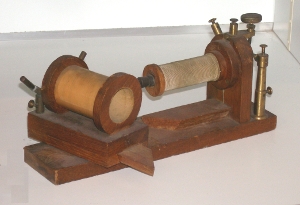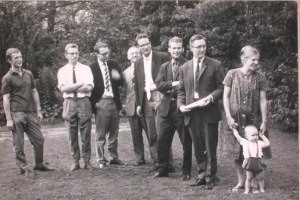Stichting De Traditie -
Cultural
Heritage



Utrecht - Science
Comparative Physiology - Electrophysiology


The 'Animate' branch of Comparative Physiology examines in particular behavior and control of behavior by the sensory, nervous, and muscular systems. Experimental stimulation of nerve and muscle tissue was done electrically, by means of a inductorium. Recording of the activity of the cardiac muscle and nerve tissue also was done electrically, by means of a string galvanometer. Few commercially available devices were in the prewar period sensitive (mV) and fast (ms) enough to record neural activity. From the publications we can deduce that after WWII the string galvanometere was replaced by the oscilloscope for the recording of nerve impulses, at least at the Laboratory of Comparative Physiology Utrecht. Krijgsman (1947) describes enthusiastically and very clearly the capabilities of that device. In 1956 Dijkgraaf publishes an article on electrophysiological recording the nerve activity of the lateral line of the clawed toad, ackowledging the contribution of his students Burgers, Elbers, and Stadhouders. Only in 1959 did the 'biological preamps' of Tektronix enter the laboratory. In the Jordan-period the focus of research was on nerves and muscles of the feet of snails; in the Dijkgraaf-period snails had to give way to the octavo-lateral system and analog structures in vertebrate aquatic animals: balance, sense of rotation, hearing, lateral line, and electrical sense. Note that Dijkgraaf too, had studied nerve conduction in the snail Aplysia in the aquarium at Naples in 1935; one and the other in close cooperation with Jordan. Judging from his publications, his experiences with the instrument have apparently led to a strong aversion to use it again.

Peter Görner, like Dijkgraaf also a pupil from the Karl von Frisch School, was requested in 1959 by Dijkgraaf to Utrecht to teach there electrophysiological methods and conduct research on the lateral line organs of the clawed toad, Xenopus laevis. Görner stayed less than three years in Utrecht, but managed to complete successfully his study of the lateral line with a breakthrough publication. He also invested in equipment, including microscopes with water-immersion lenses for the cupulae of the lateral line organs, micromanipulators for electrode holders, and electronic amplifiers. In particular, the acquisition of the Tektronix 122 low-level preamplifier laid the foundation for the subsequent electrophysiological investigations.

Adrianus Johannes
Kalmijn, continued in 1963 as assistent professor the
electrophysiological teaching tasks of Görner, and gave
further shape to the research on the biological
significance of the ampullae of
Lorenzini of cartilaginous fish. The period after
1963 is characterized by lack of space due to an explosive
increase in student numbers, which also led to Kalmijn's
departure to the USA in 1970. He received his doctorate
in 1975.


Robert Coenraad Peters was appointed in 1967 by Dijkgraaf as assistent professor to help Kalmijn in his teaching of electrophysiological methods, and to start an own PhD project on the biological significance of the ampullary organs of catfish. He interrupted his appointment at the university for 18 months conscription. In 1972, after Kalmijn had left for the USA, he was allowed to attract Franklin Bretschneider as research assistant for teaching electrophysiological techniques and to join the investigations on electroreceptive fish. Peters gains a PhD in 1974, and leaves the University of Utrecht in 2007. The team Peters-Bretschneider cooperated successfully with Cor Schönhage, electronics technician, and Wim Loos, analyst, drawing also on the expertise of a score of technicians, and animal caretakers of the Laboratory. During the period 1967 to 2006 study of the electrical sensitivity of catfish served as a basis for teaching in electrophysiology, neurophysiology and sensory physiology (e.g. electro-, chemo-, magneto, mechano- and photoreception). The pre-collection of Stichting De Traditie includes letters, research protocols, records on paper, tape, and paper tape, photographs, student reports, publications, educational documents, specific electronic and mechanic equipment, and computer programs.


Sven Dijkgraaf's correspondence underlines time after time his efforts to attract qualified electrophysiologists to reinforce his Sensory Physiology section. He seemed successful in this when Görner came to Utrecht. However, Görner returned to Germany after a couple of years, leaving teaching electrophysiology to his former student Kalmijn. Kalmijn, in turn, departed for the USA in 1970, while Thomas Szabo, nominated as lecturer of Comparative Physiology at Utrecht in 1969, stayed in Gif-sur-Yvette after all. Apparently the favorable aspects of a lectureship did not outweigh the poor spatial facilities (both private and official), and the bureaucratic atmosphere at the University.
At the instigation of Kalmijn, biology students participated after 1963 a minor of physics, in particular phenomenological electricity and electronics, to expand and operationalize their physiology skills. This resulted in a generation of biology students able to survive as independent electrophysiologists in the scientific community. However, not for long. From 1980 on, many promising scientists disappeared into anonymity as the result of various reorganizations with correponding redundancies. The destruction of scientific capital would continue till after 2010.








Franklin Bretschneider was an exceptional biology student, in that he proved already a professional electronic engineer and enthusiast electrophysiologist at the onset of his major in Comparative Physiology. The start of his term coincided with the appearance of the Philbrick guide on operational amplifiers, thus opening an easy way to build custom-made electronic equipment.
Earlier, Peters had already made a start with writing an instruction for students neurophysiology. The publishing of Erwin Neher's booklet Elektronische Messtechnik in der Physiologie (1974), ended this activity. Unfortunately, the Dutch teaching system ('Mammoetwet') yielded mainly student not mastering the German language. So again someone, Franklin Bretschneider this time, began to write an instruction manual in the Duth language, which eventually resulted in an English version.
When the book was published in 2006, the electrophysiological approach had almost completely disappeared from the faculty of Biology at Utrecht University. But to cite one of our great examples:
"It was fun while it lasted".
20220225